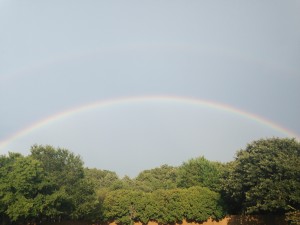
Rainbows like this one are seldom seen during a drought. This one followed an afternoon shower in Greenville, Texas in August 2013. What a welcomed sight. Virgil Seay loved to see rain and rainbows.
When I was a child I spent as much time in the summers at my maternal grandparents’ ranch in Archer County as was possible. I loved it out there and my grandfather was such a good friend. In the early evening he and I would sit under the mulberry tree after supper. Sometimes we talked but most of the time we simply listened to summer noises. That was during the drought of the 1950s, one of several disastrous droughts Virgil Seay survived.
We would speculate about the next rain and how soon it would take the waterholes to refill. Sometimes he would tell me about his early childhood and days when cattle were still driven up the Chisholm Trail. The Seay family owned land in Montague County on the Texas side of the Red River, but leased land across the river in the Chickasaw Nation of Indian Territory. In very dry weather, the land in the Territory had more grass and water. The Chickasaw were not really into the cattle business, so their lands were not as depleted as Texas ranges.
My great-grandfather Jeff Seay operated a ferry between Red River Station and the Chickasaw Nation so their home was a short distance from the trail. On summer afternoons they often heard loud rumbling sounds like thunder and saw cumulous clouds build into tall thunderheads, only to discover some Texas cattleman was moving a herd to better pastures. The noise from the travelling herd and the accompanying dust created false hopes for everyone.
That was approximately 1895 to 1897, a time of no rain up and down the Great Plains and economic uncertainty throughout the country. But the Seay family managed to survive that drought along with the ones in the 1930s and in the 1950s. Virgil was four when his first drought began, but the lack of rain and vanished hopes of thunderstorms remained with him forever. I was a little older in the 1950s but the memories of dry, hot summers, grasshoppers, and rapidly shrinking waterholes have stayed with me to this day.
I look up at the sky every summer afternoon, looking for a possible raincloud to cool things off. And when I do, I recall those wonderful visits with my granddad.
